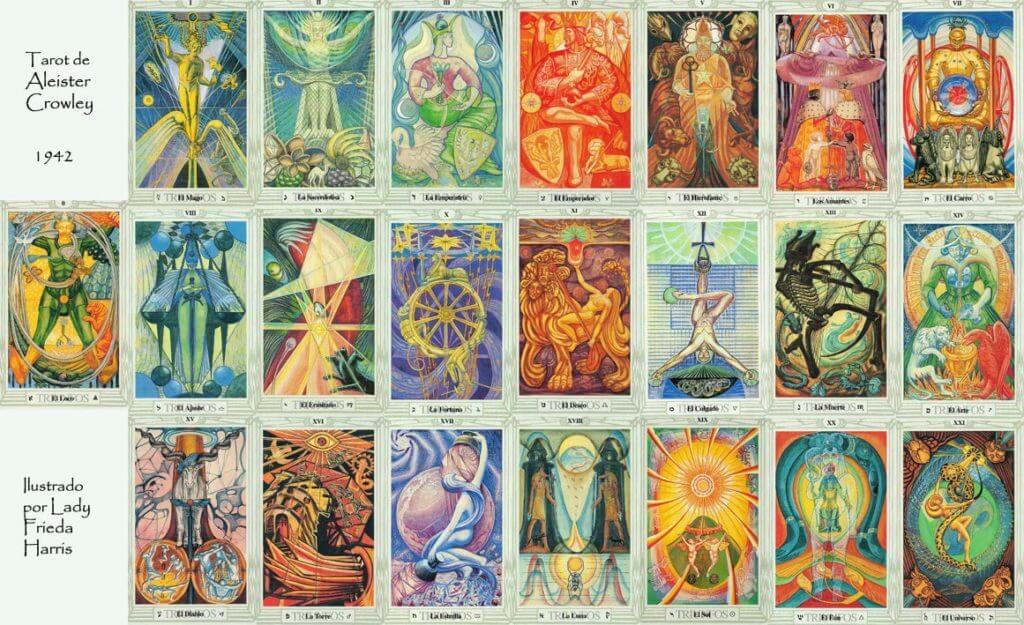June last year we had a blog post explaining: Are all tarot cards the same? The answer then was yes and no. Yes, so long as the basic ‘rules’ and structure is the same, the visual possibilities are infinite. At the same time, because visuals and symbolisms can be different, it empowers different dimensions of interpretation and, potentially, meanings. That being said, why does the Thoth Tarot Deck seem to be treated as separate from most tarot?
Same origins, different takes
The classical Rider Waite-Smith which most decks redesign these days and whose system they all primarily follow, comes from an author and illustrator from the Hermetic Order of the Golden Dawn. It was a secret society studying and practising the occult around the nineteenth and twentieth century. The Thoth tarot deck comes from a different pair of author and illustrator from the same society.
Differences in Rider Waite Smith tarot deck
On the surface level, both decks have 78 cards, with four suits and a Major Arcana. The Rider Waite-Smith was designed with the mindset of making divination more accessible and easier to learn using intuition. It contains a lot of Christian iconography which was easy for Western population to understand intuitively back in the day. It further simplifies the interpretation process by breaking it down into numerology and the four elements. The narrative of the Rider Waite-Smith meanings is more linear, following a narrative from one card to the next, known as The Fool’s Journey. Its illustrations suggest ways in which these meanings can express themselves.

Differences in Thoth tarot deck
Meanwhile, the Thoth deck, named after the Egyptian god of wisdom, writing, moon and interpreting, is rich in alchemy, the occult and Kabbalah or Jewish symbolism. It requires a lot more studying to understand these symbolisms. The Thoth deck also contains Hebrew letters, planets and signs on the cards themselves. The meanings of this deck are also non-linear, but rather interconnected with each other.
Thoth’s illustrations are more abstract, giving you space to interpret its energies yourself rather than based on illustrations. Arguably, you could have a similar effect with a minimalist tarot deck or divinating with plain poker cards. There’s also an extra dimension of meanings called Instincts, studying the card’s Shadow and Light, Purpose and Resolutions, and more.
Consider subscribing for more tips on spiritual guidance before continuing! |
The Thoth cards themselves, apart from slightly different names of the Major Arcana and Minor Suits, revert to the sequence of the Eighth (VIII) and Eleventh (XI) cards in the Major Arcana.
- Eight (VIII) is Adjustment in Thoth, equivalent to the Justice (XI)
- Eleven (XI) is Lust in Thoth, equivalent to Strength (VIii)
Also, the astrological associations of the Emperor and Star are switched:
- In Thoth, the Emperor is associated with Aquarius, not Arias.
- In Thoth, the Star is associated with Aries, not Aquarius.

Can I read the Thoth tarot deck normally like I read Tarot?
Yes, but no. One thing is that the Thoth Tarot Deck is not just intuitive like tarot, but also requires quite a lot of studying, especially studying the Kabbalah Tree of Life and many occult elements. It’s not necessary per se, but would help you truly understand the system. And because Thoth isn’t linear or narrative like Rider-Waite-Smith, there’s a new mindset of cosmic interconnectivity. It’s 78 energies constantly walking into each other, a web of doors.
Because Waite and Smith designed their tarot to be more accessible, it’s easier to create our own original design, reinterpreting the cards with, for example, Chinese mythology or with cute cats. But if La Muci wanted to design a Thoth deck, it would require much more research to come up with an original design.
Understanding Thoth Tarot by Lon Milo DuQuette is a book that explains the complexity of Thoht’s magic system in a more comprehensive, easier digested and entertaining way. Of course, the original Book of Thoth would be the most reliable source, written by the tarot’s author himself. However, not only would it take a few re-reads to truly make sense, (to some people it’s a life-long study and almost feels religious like) but also there’s a lot of controversy about the author’s ideas and practises. Still, it is possible to separate art from the artist and enjoy their work as its own entity!
Post Scriptum
Rider-Waite readers and Thoth tarot deck readers appear to be in a fight, taking one to be better than the other. You can have the same argument with Lenormand versus tarot! It’s a different approach, but in the end, is what resonated most! Thoth is not necessarily an ‘upgrade’ from thot, but does require more studying than tarot. One might argue that Fantôme is as different from Rider-Waite as Thoth because of its inclusion of two original Fantôme exclusive cards: The Artist and The Reader!
Nowadays, the Rider-Waite-Smith system inspired cards have become more popular with self-development, manifestation and spiritual guidance. Yet Thoth tarot deck is still seen as the deck for cosmic fortune telling. It's perfect for karma readings and shadow work. In the end, once again, tarot and all divination methods are a language! Some languages like English have things like past participles and future tenses, other languages don’t but have gendered endings to words, or words at the end of sentences that identify your own gender identity. You can do many things with these nuances of every language. Some thoughts are easier to deliver in different languages. Still we can use them all to communicate with anyone about anything. Divination methods are just like that.
